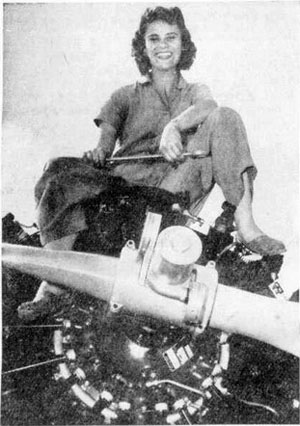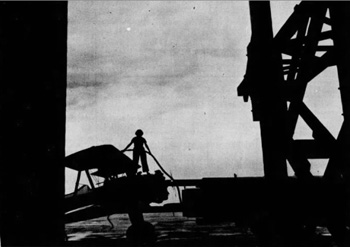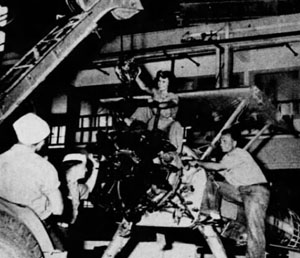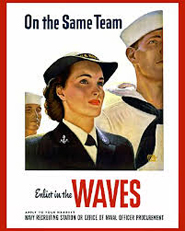
Aviation Mechanic Helen Talcott poses with wrench and airplane motor, the kind she helps fix at the naval air station. And it’s a far cry from the typewriter she used to operate on a Webster City newspaper.
Iowa Girl Helps Keep ‘Em Flying—As A Navy Mechanic At Ottumwa
By Helen Jean Talcott
(Aviation Machinist Mate, third class)
U.S. Naval Air Station, Ottumwa
This is the navy: Looking back after seven months in the women’s reserve of the United States navy, these are the things I remember.
The way my knees shook while I took the oath…..the suspense of a ride through an Iowa snow storm in a navy station wagon to the boot school at Iowa State Teachers College on December 15…..Indoctrination—which included a little bit of learning to sleep in an upper: a little mastery of navy rules and regulations, and a lot of just plain getting “salty,” which includes a small understanding of the navy way of doing and saying things.
What Is A Wrench?
My assignment to a navy school…..aviation machinist school in Memphis. I felt like rushing down to the corner drugstore to buy all the latest literature on “The Fine Art of Using a Wrench,” but I had to find out what a wrench was first …..The first weeks in A. M. M. school—studying the principals of mechanics by day and having mechanical nightmares at night, working harder than I ever intended to work in my life and yet finding time to enjoy a sailor’s pastime, going ashore.
Graduation with the first class of women mechs in navy history…..sewing my first petty officer rating badge on my sleeve—slightly crooked. The five months I’d spent learning to repair planes from empennage to engine—five months of dirt under my fingernails and grease in my hair—were rewarded when I heard a real navy man say, “Don’t let anybody kid you. You girls can do a man’s barracks…..swabbing , sheets tied in knots, navy songs, amateur shows, and beans for breakfast….This is the lighter side of life in the navy, the side we’ll spin yarns about and tell our children and grandchildren; the side we’ll remember when we’ve forgotten long hours, aching feet, and hard jobs that it seemed would never be completed.
Seven months in the navy, and I’m still a “boot” learning to keep navy planes in the air. Learning and looking forward for the duration and six months ahead of rising at 6, eating navy chow, sleeping in bunks, working every day for a boss I chose myself—Uncle Sam. I have one ambition in life—to shake hands some day with the man who could do a mech’s job at sea or an advanced base because I took his place ashore.
Editor’s Note.
This story of Helen Jean Talcott was written by herself and explains a little of the life of a WAVE in training and immediately following her arrival at a base.
Miss Talcott was born in Illinois, but her family moved to Dubuque later and Helen Jean attended grade school there. She was graduated from Webster City high, and later went to work as a reporter for the Webster City Freeman-Journal, covering general news and some society.
Her boyfriend is an aviation machinist’s mate in the navy, but when Miss Talcott enlisted she had no idea she’d be placed in the “mech” school at Memphis, Tenn.
She was graduated in the first class of women “mechs” in the history of the U.S. naval air station at Ottumwa.
The story is her own.
Source: Courier, Ottumwa, Iowa, Monday, July 19, 1943 (photo included)
![]()

Helen Talcott, a Webster City WAVE, gasses a plane at the Ottumwa Naval Air Station, where she is an aviation mechanic, third class. The photograph was taken through a door of the hangar, on of the more than 60 buildings of the air base.

Helping tear down a motor or helping assemble on, is all in a day's routine for Helen Talcott, here working with sailors who may be huskier than she is, but not a bit more enthusiastic.
Source: The Des Moines Register, August 15, 1943
![]()
Helen Jean ‘Jean' Talcott was born Aug. 23, 1922 to Frank Vern and Maude Payne Talcott.
Jean joined the Navy in 1942 where she met her husband, Lindley Stanford Wicks. Sr. She attended Aviation Mechanics school, N.T.S., Memphis TN and also served at the Naval Training Station in Ottumwa, IA.
She died July 23, 2004 and she and Lindley are both buried in Tahoma National Cemetery, Kent, WA.
Sources:
Daily Freeman Journal, Webster City, IA
ancestry.com
![]()
